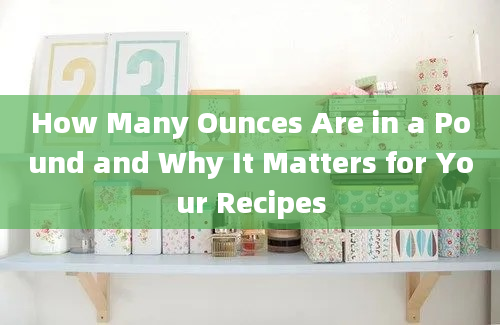How Many Ounces Are in a Cup for Accurate Baking Measurements

Baking is an exact science where precise measurements are crucial for achieving the desired outcome. One of the most common conversions you'll encounter is determining how many ounces are in a cup. This knowledge is essential for accurately following recipes and ensuring your baked goods turn out perfectly.
Understanding the Standard Measurement
In the United States, the standard measurement for a cup is 8 fluid ounces. This is a widely accepted conversion used in most culinary practices. According to the United States Department of Agriculture (USDA), a cup is defined as 8 fluid ounces, which is equivalent to approximately 236.59 milliliters [USDA](https://www.usda.gov).
Dry vs. Liquid Ingredients
It's important to note that the conversion can vary slightly depending on whether you are measuring dry or liquid ingredients. For liquid ingredients, the conversion is straightforward: 1 cup equals 8 fluid ounces. However, for dry ingredients, the weight in ounces can differ due to the density of the ingredient. For example, 1 cup of flour weighs approximately 4.5 ounces, while 1 cup of sugar weighs about 7 ounces.
Why Precision Matters in Baking
Baking relies on chemical reactions that require precise ratios of ingredients. Even a small deviation can result in significant changes to the texture, flavor, and appearance of the final product. For instance, too much flour can make your baked goods dense and dry, while too little can cause them to collapse.
Tools for Accurate Measurements
To ensure accuracy, it's recommended to use measuring cups and spoons specifically designed for either dry or liquid ingredients. The American Baking Association emphasizes the importance of using the correct measuring tools to achieve consistent results [American Baking Association](https://www.ameribake.org).
Conversion Chart for Common Ingredients
Here is a quick reference chart for the weight of 1 cup of some common baking ingredients:
Allpurpose flour: 4.5 ounces
Granulated sugar: 7 ounces
Brown sugar (packed): 7.5 ounces
Butter: 8 ounces
Water: 8 fluid ounces
Conclusion
Understanding the precise measurements in baking is key to success. While 1 cup is generally equivalent to 8 fluid ounces for liquids, the weight can vary for dry ingredients. Always refer to a reliable conversion chart and use the appropriate measuring tools to ensure your baked goods come out perfectly every time.
Frequently Asked Questions (FAQs)
Q1: How many fluid ounces are in a cup?
A1: There are 8 fluid ounces in a cup according to the United States Department of Agriculture (USDA) [USDA](https://www.usda.gov).
Q2: Does the number of ounces in a cup change for dry ingredients?
A2: Yes, the weight in ounces can vary for dry ingredients due to their density. For example, 1 cup of flour weighs about 4.5 ounces.
Q3: Why is precise measurement important in baking?
A3: Precise measurement is crucial in baking because it ensures the correct chemical reactions occur, which affects the texture, flavor, and appearance of the final product.
Q4: What is the weight of 1 cup of allpurpose flour in ounces?
A4: One cup of allpurpose flour weighs approximately 4.5 ounces.
Q5: How much does 1 cup of granulated sugar weigh?
A5: One cup of granulated sugar weighs about 7 ounces.
Q6: Can I use the same measuring cup for both dry and liquid ingredients?
A6: It's best to use measuring cups designed for specific types of ingredients (dry or liquid) to ensure accuracy.
Q7: How many ounces does 1 cup of packed brown sugar weigh?
A7: One cup of packed brown sugar weighs approximately 7.5 ounces.
Q8: What is the weight of 1 cup of butter in ounces?
A8: One cup of butter weighs 8 ounces.
Q9: Is the conversion from cups to ounces the same in all countries?
A9: No, the conversion can vary by country. The 8 fluid ounces per cup standard is specific to the United States.
Q10: Where can I find a reliable conversion chart for baking ingredients?
A10: Reliable conversion charts can be found on authoritative websites like the USDA [USDA](https://www.usda.gov) and the American Baking Association [American Baking Association](https://www.ameribake.org).
By following these guidelines and understanding the nuances of measuring ingredients, you can ensure your baking endeavors are consistently successful.










